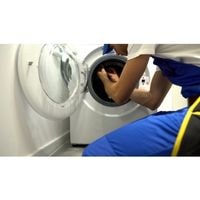Bosch dryer not drying. Whether your clothes come out a little damp or completely wet, we understand that it might make you feel like you’ve just wasted time and money on something that doesn’t work.
When this happens all is not lost, however, cleaning the lint filter and testing your moisture sensor resolves the issue.
Bosch dryer not drying

Appliances are so important to us that when they break down, we often fear the worst.
Bosch tumble dryer troubleshooting reveals that these common causes for dryers not drying can be fixed easily.
Check Blower Wheel
The blower wheel works together with the motor to draw air into the drum of your dryer when drying clothing.
When lint or clothing like small socks can escape the screen and gets stuck in the blower wheel, it blocks airflow, which causes your clothes to take too long to dry and that’s something we cannot allow.
Therefore, when performing this repair make sure you look for any visible obstructions related to the blower wheel turning slowly or not at all, and if no obstructions are present,
manually turn the blower wheel on occasion to see if it moves easily around the center axle (if it does then we know it is working properly).
Defective Gas Valve Solenoid
Two or more gas valve solenoid coils are present in gas dryers. In addition to opening the gas valve, gas valve solenoids prevent the flow of gas out of the burner assembly.
Unfortunately, these valves sometimes fail several minutes into the drying cycle, causing all sorts of chaos to boil over before they’re able to even fully heat up.
Inspect the igniter (the heating coil) to determine whether one or more of the gas valve solenoids has failed.
If it glows but goes out without igniting anything at all, then that one is defective and we suggest you replace it with a new one.
Thermistor problem
Some dryer models are able to detect the temperature inside of the machine with the help of a thermistor.
The control board should use this assistance to cycle the heat on and off.
However, if it’s not functioning correctly, there may be no regulation when it comes to determining how hot the machine has gotten and consequently performing the appropriate action such as turning on or off accordingly.
Replace the moisture sensor
The moisture sensor measures the moisture level of clothes and sends a signal to the control board if it is dry.
If the sensors are reporting incorrectly, then you will run the risk of having excess moisture in your clothing.
However, this can be a rare occurrence and for more likely reasons should be examined first. Before replacing your sensor, check all other working components. If everything else is working correctly then replace the sensor.
Clean your dryer
In the event that your dryer’s venting system has been partially or even completely clogged, it would substantially increase your drying time in comparison to a situation where there is no restriction whatsoever.
The dryer’s venting system should be cleaned 1-2 times annually to ensure proper performance, taking care not to delay cleanings for longer than necessary.
Faulty Heating Element
It is warmed by the heating element before entering the dryer drum. Any part of the dryer assembly that is defective, including the heating element, may lead to the dryer, not heating.
Check the heating element’s continuity with a multimeter to find out if it is defective. If there is no continuity in the heating element, replace it.
Lint Filter clogged
The lint filter on the back of your dryer is probably clogged. Fabric softener and dryer sheets can leave a residue on the lint filter, reducing airflow.
To fix this problem quickly and easily, you may want to try running a few cycles without any laundry in the dryer.
If that doesn’t work, remove the filter and clean it using water and white vinegar or an equal mixture of both.
Cycling Thermostat fault
The cycling thermostat turns the heat on and off in order to regulate the air temperature. A bad cycling thermostat prevents the dryer from heating.
Fortunately, this rarely happens. Before replacing the cycling thermostat, check all the more commonly defective parts.
If all of the other components are functioning properly, test the thermostat for continuity with a multimeter. Replace a faulty thermostat if necessary.
